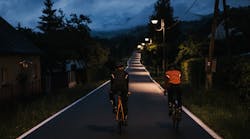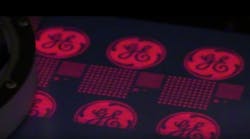The Unified System of Photometry provides an objective method for optimizing the spectrum of a light source, while minimizing energy use and at the same time maintaining good visibility. The system was designed to characterize light at any level, including the mesopic level where both rods and cones operate (see below).
“In nighttime conditions, the human eye is more sensitive to short-wavelength light, which produces ‘cool’ tones like blue or green, as opposed to long-wavelength light, which produces ‘warm’ tones like yellow and red,” said LRC Director of Energy Programs Peter Morante.
“By replacing traditional, yellowish high-pressure sodium (HPS) lights with ‘cool’ white light sources, such as induction, fluorescent, ceramic metal halide, or LEDs, we can actually reduce the amount of electric power used for lighting while maintaining or even improving visibility in nighttime conditions.”
The eye has two types of visual receptors in the retina, cones and rods. The current system of photometry—the measurement of visible light in terms of human perception for certain activities like reading and seeing fine details—is based on how some cones respond to different wavelengths.
Cones are the dominant visual receptor under photopic (daylight) lighting conditions. Rods function primarily under very dim conditions.
According to Morante, it is necessary to redefine the luminous efficacy functions needed for nighttime applications where electric lighting is used, and both rods and cones contribute to vision. The LRC’s Unified System of Photometry was designed to characterize light at any level, including the mesopic level where both rods and cones operate.
According to LRC Director Mark Rea, researchers around the world are also concluding that the current system of photometry could use some updating to better characterize light source performance under nighttime conditions. Rea says that the International Commission on Illumination (CIE) will be releasing its own form of unified photometry for outdoor lighting.
Saving energy
LRC field demonstration results from the past few years in rural and suburban areas of Connecticut, Massachusetts, and Texas verified that by implementing the Unified System of Photometry the street lighting system consumed 30 to 50 percent less electric power and the residents believed they could see better and said they felt safer, when compared to lighting systems designed using the traditional system of photometry.
There is now renewed interest in the research, according to Morante, as an increasing number of cities and towns across the U.S. are examining ways to save energy either through a reduction or a change in outdoor lighting.
The researchers estimate that about half of the approximately 13 million streetlights in the United States have the opportunity to significantly reduce energy consumption by as much as 50 percent, translating to an annual savings of 1 billion kWh, and a reduction in power plant CO2 emissions of 546,000 tons per year.
Field studies and references
A full report detailing energy use, consumer acceptance and perceptions, visibility, and light levels for one of the LRC’s field tests in the City of Groton, Connecticut, was published last year.
In the LRC field studies, the mesopic street lighting system met all utility requirements and, in addition to significant reductions in energy consumption, was preferred by residents over the yellow-appearing HPS system.
The following selected technical papers explain the Unified System of Photometry:
- Rea, M., J.D. Bullough, J.P. Freyssinier, and A. Bierman. 2004. A proposed Unified System of Photometry. Lighting Research and Technology 36(2): 85-111.
- Rea, M., Z. Yuan, and A. Bierman. 2009. The Unified System of Photometry Applied to Remote Airfield Lighting. Lighting Research and Technology 41(1): 51-70.
Learn more about LRC’s outdoor and street lighting research at these LRC Program pages:




